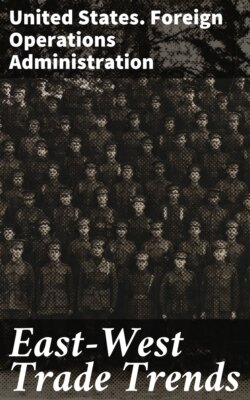Читать книгу East-West Trade Trends - United States. Foreign Operations Administration - Страница 18
The New Trade Agreements
ОглавлениеIn a period of about 3 weeks, in late July and early August, the U.S.S.R. concluded trade agreements with France, Greece, Argentina, Denmark, and Iceland. These were not mere renewals of expiring agreements. The U.S.S.R. had never before had trade agreements with France, Greece, or Argentina (or any other Latin American country). Its last trade agreement with Denmark had expired in 1950, and with Iceland in 1947. Its trade with three of the countries, Greece, Iceland, and Argentina, had been almost nonexistent in recent years. Considerable trade, however, had been carried on with France and Denmark without benefit of trade agreements.
The U.S.S.R. also renewed existing trade agreements with Iran and Afghanistan and signed a “payments agreement” with Egypt. Most of these trade agreements signed during the summer of 1953 became effective as of July 1.
The second group of trade agreements, clustered shortly before or after January 1, 1954, and mainly effective as of that date, was with India, Belgium, Norway, Sweden, and Finland. It was the first time the U.S.S.R. had ever had a trade agreement with India. There had not been one with Belgium since 1951. The others were renewals. Barter deals were also made with some of the countries already mentioned, and with Israel and Japan.
Not since 1948, when the U.S.S.R. had entered into annual or long-term trade agreements with eight countries of Western Europe, had there been a period of Soviet trade-agreement activity that could compare with the paper blitzkriegs just described. And the result was that in the early part of 1954 the U.S.S.R. had trade agreements with more free-world countries than at any other time in the postwar period.
This fact and the hefty amounts of trade which were called for in some of the agreements have given many people the impression that a historic increase in the size of East-West trade was taking place. The impression seems hardly justified.
In the first place, trade agreements are usually only hunting licenses. They merely authorize—but do not guarantee—the exchange of goods. The governments agree to permit the export and import of the types listed—if contracts can be arrived at between Soviet monopolies and Western business. If the goods turn out to be unavailable, or if the demand is not forthcoming, or if the price is too high or the quality too low, the publicized amounts of the trade agreements do not materialize in the export-import statistics. And this fact rarely receives as much public attention as the original announcement. To illustrate, a spokesman for the Greek Foreign Ministry told the press on January 19 that the U.S.S.R. had lagged far behind in shipments under the 1-year trade agreement of July 1953. That agreement had been publicized as calling for trade of $10 million each way, but the Greek official said few Russian deliveries had been made and “it will be a miracle” if these deliveries reached $3 million.
In the second place, even a big percentage of fulfillment would not necessarily increase trade between the U.S.S.R. and the free world to the high points of 1948 and 1952. The 1948 turnover—that is, the sum of exports and imports—had been about $1 billion. It declined to $545 million in 1950. By 1952 it was back up to $943 million. The preliminary estimate for 1953 is $790 million. Thus the year which saw the Kremlin’s new trading tactics was also the year that saw a slump of about 16 percent in the dollar value of its trade with the free world. The trade was rising moderately in the last part of 1953 and a further moderate rise in 1954 would not be surprising.
